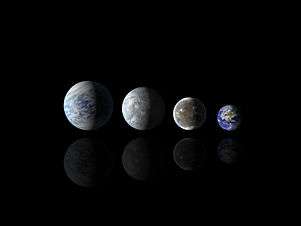Kepler-68b
| Exoplanet | List of exoplanets | |
|---|---|---|
| Parent star | ||
| Star | Kepler-68 (KOI 246) | |
| Constellation | Cygnus | |
| Right ascension | (α) | 19h 24m 07.7651s[1] |
| Declination | (δ) | +49° 02′ 24.936″[1] |
| Apparent magnitude | (mV) | 8.588 |
| Distance | 490±20[1] ly (149±5[1] pc) | |
| Mass | (m) | 1.079±0.051 M☉ |
| Radius | (r) | 1.243±0.019 R☉ |
| Temperature | (T) | 5793±74 K |
| Metallicity | [Fe/H] | 0.12±0.074 |
| Age | 6.3 ± 1.7 Gyr | |
| Physical characteristics | ||
| Mass | (m) | 5.79 M⊕ |
| Radius | (r) | 2.31±0.07 R⊕ |
| Density | (ρ) | 2.60±0.74 g cm−3 |
| Temperature | (T) | 1,280 K (1,010 °C; 1,840 °F) |
| Orbital elements | ||
| Semi-major axis | (a) | 0.06170 AU |
| Orbital period | (P) | 5.398763 d |
| Inclination | (i) | 87.60±0.9° |
| Discovery information | ||
| Discovery date | 12 February 2013 | |
| Discoverer(s) | ||
| Discovery method | Transit (Kepler Mission) | |
| Other detection methods | Radial velocity | |
| Discovery status | Confirmed | |
| Other designations | ||
KOI 246.01 | ||
Kepler-68b is an exoplanet orbiting the Sun-like star Kepler-68 in the constellation of Cygnus. Discovered by planetary-transit methods by the Kepler space telescope in February 2013, it has a radius of 2.31 ± 0.07 that of Earth and a density of 2.46–4.3 g/cm3. It has an orbital period of 5.398763 days at a distance of about 0.0617 AU from its star.[2] Doppler measurements were made to determine its mass to be 5.79 times that of Earth (0.026 MJ).[3]
With a density of 2.6 g/cm3 it has physical characteristics of both a super-Earth and a mini-Neptune.[4]
See also
References
- 1 2 3 4 Brown, A. G. A; et al. (2016). "Gaia Data Release 1. Summary of the astrometric, photometric, and survey properties". Astronomy and Astrophysics. 595. A2. arXiv:1609.04172. Bibcode:2016A&A...595A...2G. doi:10.1051/0004-6361/201629512. Gaia Data Release 1 catalog entry
- ↑ Gilliland, Ronald L.; et al. (2013). "Kepler-68: Three Planets, One with a Density Between That of Earth and Ice Giants". The Astrophysical Journal. 766. 40. arXiv:1302.2596. Bibcode:2013ApJ...766...40G. doi:10.1088/0004-637X/766/1/40.
- ↑ http://astro.berkeley.edu/~gmarcy/22kois.pdf
- ↑ Masses, radii, and orbits of small Kepler planets: the transition from gaseous to rocky planets accessdate=8 January 2014
This article is issued from
Wikipedia.
The text is licensed under Creative Commons - Attribution - Sharealike.
Additional terms may apply for the media files.


